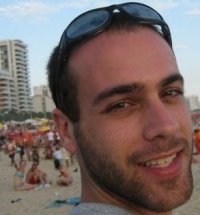



Point and click back. I just attended the media opening of a local photo gallery that specializes in presenting visually stunning photography about historical events involving the "other." Entitled "Ghosts in the Machine," the photos dug back into the collective subconscious in several different parts of the globe. The pastiche format blended together an investigation of the current state of a frozen historical memory by placing this slice of time into the context of the present. The curious mix of historical truth and its concurrent possibilities forms a range of aesthetic options that become the postmodern photographer's menu from which to assemble a coherent artistic vision. Renditions of such hybrid reality between past and present reveal one's ability to transport oneself temporally into the landscape of a past epoch for the sake of re-inserting historical subjects into that window of extraordinary historical relevance.
The reason why the SF Camerawork exhibition struck my fancy relates to my penchant for sifting through collective memories in order to spit out frozen chunks of the past. These both delectable and horrific pieces of universal memory serve to re-engage our historical palates by facilitating the insertion of deceased souls into two-dimensional frames, by merging technical observations with an accurate depiction of the historical record, and by weaving together the ghosts of the past with the deliberations of the present era.
Perhaps one can never exhaust the possibilities of such play with historical snapshots and the human representations that can be attributed to a specific context during war, in the wilderness, or on the edge of civilized existence. The most notable parts of Ghosts in the Machine were depections of grave injustice that continue to afflict the survivors of bygone dimensions. The essence of constructing historical memory on the foundations of assorted archival footage and substantive subjective interplay is a nexus between peoples and between periods of time.

One set of photographically wise images of northern Scandinavia reminds us about the ancestors of the Lapplander (Sami) people who inhabit the vast expanses of snowy wilderness in the northern regions of Scandinavia. Frozen literally to the bark of placid birch trees, the faces of these Sami spirits remind us of the sovereignty once enjoyed by these folks over the land. Now there are competing claims to dominion over this land, and the nostalgic belief that these ghosts peacefully planted their life-seeds in these hallowed forests gives us hope. Perhaps we can be encouraged to dig through the images of our collective history to eke out an irreversible sense of rehabilitation of the old arrangement.
Another creative investigation into the events of the past was conducted by a Lebanese artist who sought to piece together the fragments of car bombs during the Lebanese Civil War that ravaged his country from 1975 to 1991.
 By documenting the cars that were nefariously commissioned to carry the hundreds of kilos of explosive matter into close contact with the tens of civilians whose lives were senselessly ended seconds later, the artist lends credibility and universality to the murderous act. The statement is elicited: thou might employ any motor vehicle to strap down TNT sufficient enough to send scores of unaware and undeserving human beings to their final resting place.
By documenting the cars that were nefariously commissioned to carry the hundreds of kilos of explosive matter into close contact with the tens of civilians whose lives were senselessly ended seconds later, the artist lends credibility and universality to the murderous act. The statement is elicited: thou might employ any motor vehicle to strap down TNT sufficient enough to send scores of unaware and undeserving human beings to their final resting place. 
Syphilitic symbols comprise one of the other demonstrative sets of visual memory. One clever American photographer trekked down to actual Southern hospitals (infamously lacking in Southern hospitality but endowing with Southern death eventuality) where doctors infected black men with syphilis under the auspices of the Tuskeegee Experiment. This photo concept involves digitally inserting the cutouts of poor black farmers from the dirty dirty Deep South into scenes of medical shamefulness. As white nurses and doctors snatched up black male bodies with which to run sinister venereal disease tests, the syphilitic patients scream forth their sacrificial innocence - mere lambs set aside for gradual yet tormented slaughter. These images allow the viewer to share solidarity with sharecroppers whose fates the medical establishment threw into the vacuum of venereal vilification. The photo above is of a wooden cast of vertical, standing cut-outs of a WW1 vet who returned from the frontlines to a life of institutionalization.

The last of the photo sets on display that appealed to my historical interest was Dinh Q Le's highly technical presentation of Vietnam's ghosts, from Hollywood to the jungle. Weaving together the strands of interlocking photos with a process typically used for grass mat weaving, Le creates a quintessentially postmodern photo collage. The photos that link together Sergeant Pyle with the folk experiences of Vietnamese people during the sanguine conflict create a feeling of historical unity that bridges the American appreciation of the events in Southeast Asia with the visceral experiences of civilians caught up in the atrocious quagmire.




No comments:
Post a Comment